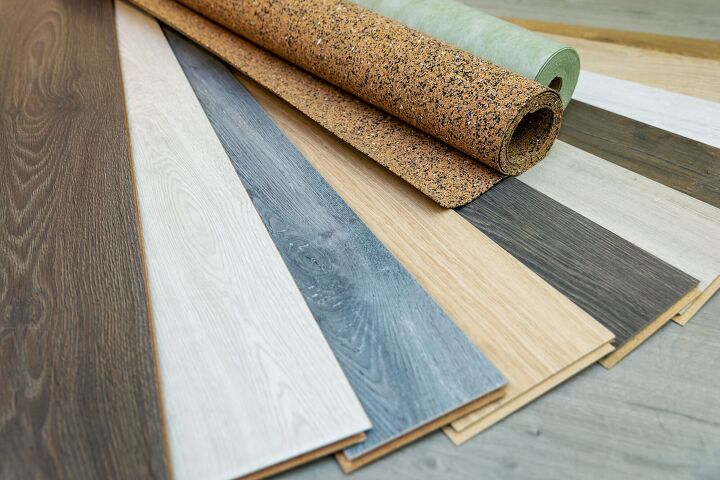Can You Use Carpet Padding Under Laminate Flooring?

When it comes to laminate flooring installations, underlayment is a thin, flexible piece of material that is placed on top of the subfloor to serve as a base layer for the laminate tiles or planks that are to be installed. While the subfloor gives the room structural support, the underlayment is responsible for supporting the laminate flooring itself.
To get the most out of your floors, and ensure longevity and protection, it’s important that the laminate is installed properly. Perhaps you’ve decided to make the switch from carpeting to laminate and are wondering whether or not it’s possible to simply use the existing carpet padding as the underlayment for your new laminate flooring.
Simply put, you should not use carpet padding under laminate flooring. When you tear out the carpet, it’s important that everything down to the subfloor is removed. The reason for this has to do with the fact that carpet padding is too thick to properly support your newly installed laminate floors.
Continue reading for our comprehensive guide on laminate flooring underlayment, including a detailed description as to why it’s not recommended to use carpet padding under laminate.
Can I Install Laminate Flooring Over Carpet Padding?
The carpet padding is meant to serve as a shock absorber, allowing the carpet to bounce back and recover when it is exposed to foot traffic and heavy wear. As such, it prevents the carpet pile from flattening out and ensures that the carpet looks presentable for a longer period of time.
While it may seem logical and more cost-effective to only rip out your carpeting and repurpose the carpet padding as an underlay for your new laminate floors, this is not recommended. When removing the carpeting, you also must remove everything down to the subfloor. In short, carpet underlayment is too thick to be used as underlayment for laminate.
Generally speaking, most laminate flooring underlayment is between 1mm and 3mm thick. Carpet padding, on the other hand, use usually around 8mm to 10mm thick. Using carpet padding under laminate floors will cause your floor to be too bouncy and potentially result in damage to the locking system.
To ensure that your laminate flooring can be installed properly, both the carpet and the carpet padding must be removed. Additionally, the subfloor needs to be smooth, level, and free of debris to allow for a seamless surface to install the laminate planks or tiles.
NOTE: Pay close attention to your flooring’s warranty when you’re considering the type of laminate flooring underlayment to use. Not adhering to their recommendations may void your warranty.
Laminate Flooring Underlayment
Often made out of polyethylene or polypropylene, laminate flooring underlayment is a thin foam pad that is installed underneath the laminate and atop the subfloor. Nowadays, most laminate flooring requires that an underlayment be installed. Although some manufacturers offer laminate floors with the underlayment already attached, this is often a special feature that is not outfitted with all laminate products.
Laminate flooring underlayment serves a number of purposes. For starters, it slightly levels and corrects minor deviations in your subfloor. It also provides cushion to laminate planks, reduces sound transmission, and slightly enhances the R-value of the floor.
Why Is Laminate Flooring Underlayment Needed?
Since laminate flooring should not be glued or nailed in place, it needs some sort of cushion for between the flooring and the subfloor below. This will allow it to float easily and expand and contract according to temperature changes. Underlayment also helps avoid damage caused by friction between the subfloor and the laminate, creating a smooth surface for the laminate flooring to float.
Proper selection and installation of underlayment is crucial since it will impact how your laminate floors feel and wear over time. Laminate flooring underlayment should be chosen based on the specific environment, the type of floor selected, and your individual needs for the space. You should also closely follow all manufacturer instructions regarding underlayment to avoid voiding the warranty.
Concrete vs. Plywood Subfloors
The type of laminate flooring underlayment that you choose should be directly influenced by the subfloor the floors are being installed on. When it comes to concrete subfloors, moisture is the main concern. Since concrete is porous, water can easily seep into it and cause the flooring to loosen, warp, and grow mold or mildew. With concrete subfloors, it’s important that you opt for an underlayment that also acts as a moisture barrier. In most cases, the ideal choice is a thin, foam material that rolls out in sheets and is made from polyethylene or polypropylene.
For plywood or OSB subfloors, on the other hand, a breathable foam-type underlay is commonly used under laminate flooring. You typically won’t want to use an underlayment that also serves as a vapor barrier, as wood needs to breathe. When you install a vapor barrier over a natural material, this can actually cause moisture to get trapped inside, the material to warp or mold to grow.
The only exception is when the laminate flooring is being installed in high moisture location, like a basement or bathroom. In this case, a moisture barrier underlayment is recommended.
Types of Laminate Underlayment
Using carpeting padding or any other soft, thick underlayment as the underlay for laminate flooring is a common mistake that some homeowners make. Many assume that these materials will increase the comfort of laminate, but it will actually cause the floor to flex in a way that can loosen the joints.
Proper underlayment for laminate flooring is very thin layers of foam that provide slight cushioning but aren’t noticeable underfoot. This underlayment comes in rolls and is installed right over the subfloor by rolling it out and sealing the seams using adhesive strips. In some instances, the adhesive comes pre-attached to the underlayment.
1. Standard Foam Underlayment
Standard foam underlayment is the most common form of laminate underlayment. It is comprised of a thin layer of foam material that serves as a cushion between the laminate flooring and the subfloor. This type of underlayment is typically used when installing laminate floors over plywood or OSB subfloors. However, standard foam underlayment should not be used in high-moisture situations, as it doesn’t provide any vapor barrier characteristics.
2. Combination Foam Underlayment
As the name indicates, this form of underlayment is a combination of standard foam and a vapor barrier layer that shields against moisture. It is slightly more expensive than standard foam underlayment and is recommended for plywood, OSB, and concrete subfloors. This underlayment can be used in almost all environments, but should be the go-to for moist locations like bathrooms and basements.
3. Cork Underlayment
One of the most expensive options for underlayment, cork can often add as much as 50 percent to the total cost of laminate flooring installation. This type of laminate underlayment is ideal for installations where noise reduction is a priority, which may be desired in certain working environments or bedrooms. It is also naturally antimicrobial, which can add a healthy component to your laminate flooring installation.
Although cork underlayment doesn’t provide additional cushioning or comfort under the floors, it can be beneficial for leveling out uneven surfaces between rooms. Since cork is not moisture-proof, when it’s used in moist environments as an underlayment it is commonly laid over a sheet of plastic that acts as the chief moisture barrier.
Laminate Flooring with Attached Underlayment
Nowadays, it’s common to find laminate floors that are manufactured with the underlayment attached to the underside of the product. Fortunately, with these products, you do not have to buy and install a separate foam underlayment.
In most cases, laminate flooring with attached underlayment is installed right over top of a plywood or OSB subfloor. Though, there are some types that are appropriate for use on concrete subfloors or in other wet locations without the need for an extra vapor barrier seal.

Jessica considers herself a home improvement and design enthusiast. She grew up surrounded by constant home improvement projects and owes most of what she knows to helping her dad renovate her childhood home. Being a Los Angeles resident, Jessica spends a lot of her time looking for her next DIY project and sharing her love for home design.
More by Jessica Stone



























